 Website:
Shaw Moisture Meters
Website:
Shaw Moisture Meters
Catalog excerpts

Portable Sample System For SDHmini Dewpoint Meters Instruction Manual Issue 1
Open the catalog to page 1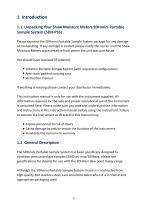
1 Introduction 1.1 Unpacking Your Shaw Moisture Meters SDHmini Portable Sample System (SDH-PSS) Please examine the SDHmini Portable Sample System package for any damage or mishandling. If any damage is evident please notify the carrier and the Shaw Moisture Meters representative from where the unit was purchased. You should have received (if ordered): ● SDHmini Portable Sample System (with requested configuration) ● Anti-static padded carrying case ● Instruction manual If anything is missing please contact your distributor immediately. This instruction manual is only for use with the...
Open the catalog to page 3
Do not drop or shock the instrument, especially when a dew point meter is installed to the SDHmini Portable Sample System, as damage could occur to both instruments. The SDHmini Portable Sample System is provided, as standard, with an antistatic padded carrying case with adjustable shoulder straps and an instruction manual. Because there are no possible source of ignition or stored energy components, the SDHmini Portable Sample System can be used with the intrinsically safe Model SDHmini-Ex in hazardous environments. 1.3 General Arrangement Example* Double Toggle Zip Pocket for User Manual...
Open the catalog to page 4
2 Safety Information It is the responsibility of the user to ascertain the suitability of the SDHmini Portable Sample System (SDH-PSS) for use in hazardous areas. 2.1 Explanation of Prohibition, Warning and Note Symbols Used Local health and safety regulations should be observed as should the safety critical prohibitions, warnings and notes highlighted in this instruction manual. DO NOT Prohibited actions or behaviours WARNING Danger to personnel and/or damage to equipment NOTE Additional information 2.2 Pressure Exposure The maximum pressure to which the telescopic measuring head is...
Open the catalog to page 5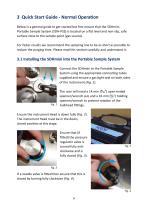
3 Quick Start Guide - Normal Operation Below is a general guide to get started but first ensure that the SDHmini Portable Sample System (SDH-PSS) is located on a flat level and non-slip, safe surface close to the sample point (gas source). For faster results we recommend the sampling line to be as short as possible to reduce the purging time. Please read this section carefully and understand it. 3.1 Installing the SDHmini into the Portable Sample System Connect the SDHmini to the Portable Sample System using the appropriate connecting tubes supplied and ensure a gas tight seal on both sides...
Open the catalog to page 6
3.2 Connecting a Sample Line Before connecting a sample line to the isolation valve at the gas source, first check that the gas to be sampled is free from excessive moisture and/ or particle contaminants by placing a white filter paper (or similar) approximately 10 mm from the outlet and slowly opening the isolation valve to achieve a steady flow of gas/air onto the white filter paper for approximately one minute (Fig. 5). If contaminants are seen on the white filter paper, a filter unit must be installed at the isolation valve outlet and before the sample hose. When the filter unit is...
Open the catalog to page 7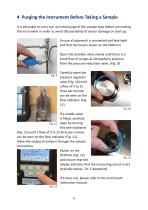
4 Purging the Instrument Before Taking a Sample It is advisable to carry out an initial purge of the sample loop before connecting the instrument in order to avoid the possibility of sensor damage on start up. Ensure all pipework is connected and leak tight and that the head is down on the SDHmini. Open the isolation valve slowly until there is a small flow of air/gas at atmospheric pressure from the pressure reduction valve. (Fig. 9) Fig. 9 Carefully open the pressure regulator valve (Fig. 10) until a flow of 5 to 15 litres per minute can be seen on the flow indicator. (Fig. 11). If a...
Open the catalog to page 8
After purging for a minimum of two minutes, place a finger over the vent on the flow indicator until the desiccant head on the instrument is fully raised (Fig. 14). Pulling up the head will draw moisture from ambient air in the work place into the head chamber where the sensor is exposed and will result in a contaminated sample and give a false measurement. When the desiccant head is fully extended and the sensor exposed to the sample gas, the displayed moisture reading should rise to that of the sample gas. Take a reading when the dewpoint value on the screen has settled and is stable...
Open the catalog to page 9
5 Disconnection - Follow This Procedure Exactly DO NOT Do not disconnect any connections whilst the isolation valve at the gas/air source is still open. Doing so could cause serious injury to the operator and persons near by. DO NOT Do not turn off the pressure regulator or needle valve at this stage. Doing so will retain pressure in the sample line. First, TURN OFF the isolation valve fully and allow the system to fully depressurise (Fig. 19). When the ball in the flow indicator has fallen to “0” (zero litres per minute) as shown in Fig. 20, it is now safe to disconnect the sample line...
Open the catalog to page 10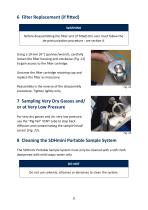
6 Filter Replacement (if fitted) WARNING Before disassembling the filter unit (if fitted) the user must follow the de-pressurisation procedure - see section 4. Using a 19 mm (¾”) spanner/wrench, carefully loosen the filter housing anti-clockwise (Fig. 21) to gain access to the filter cartridge. Unscrew the filter cartridge retaining cap and replace the filter as necessary. Reassembly is the reverse of the disassembly procedure. Tighten lightly only. 7 Sampling Very Dry Gasses and/ or at Very Low Pressure For very dry gasses and /or very low pressure, use the “Pig-Tail” VENT tube to stop...
Open the catalog to page 11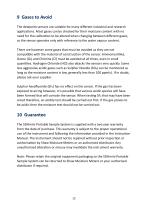
9 Gases to Avoid The dewpoint sensors are suitable for many different industrial and research applications. Most gases can be checked for their moisture content with no need for the calibration to be altered when changing between different gases, as the sensor operates only with reference to the water vapour content. There are however some gases that must be avoided as they are not compatible with the material of construction of the sensor. Ammonia (NH3), Ozone (O3) and Chlorine (Cl) must be avoided at all times, even in small quantities. Hydrogen Chloride (HCl) also attacks the sensors...
Open the catalog to page 12






























